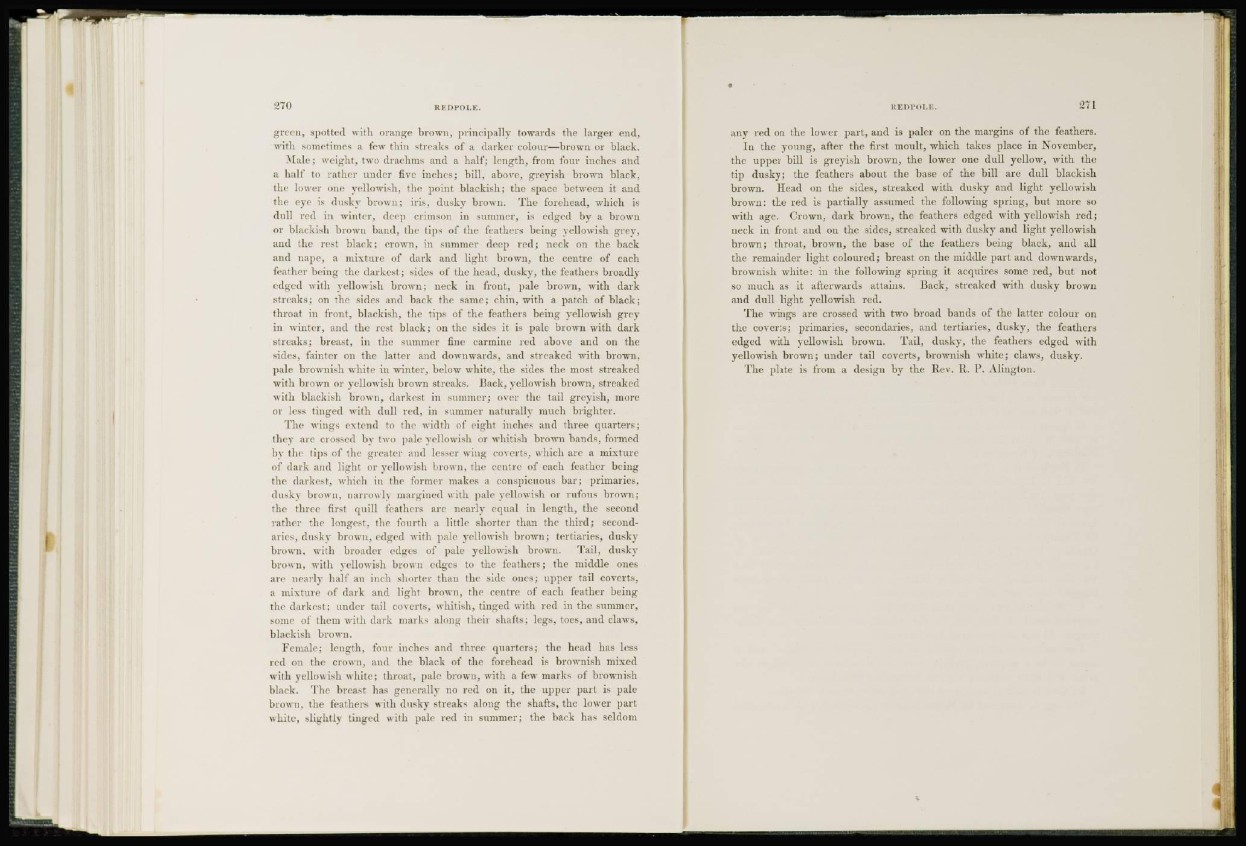
270 R E D P O L E .
green, spotted with orange brown, principally towards the larger end,
with sometimes a few thin streaks of a darker colour—brown or black.
Male; weight, two drachms and a half; length, from four inches and
a half to rathe]- under five inches; hill, above, greyish brown black,
the lower one yellowish, the point blackish; the space between it and
the eye is dusky brown; iris, dusky brown. The forehead, which is
dull red in winter, dee]) crimson in summer, is edged by a brown
or blackish brown band, the tips of the feathers being yellowish grey,
and the rest black; crown, in summer deep red; neck on the back
and nape, a mixture of dark and light brown, the centre of each
feather being the darkest; sides of the head, dusky, the feathers broadly
edged with yellowish brown; neck in front, pale brown, with dark
streaks; on the sides and back the same; chin, with a patch of black;
throat in front, blackish, the tips of the feathers being yellowish grey
in winter, and the rest black; on the sides it is pale brown with dark
streaks; breast, in the summer hue carmine red above and on the
sides, fainter on the latter and downwards, and streaked with brown,
pale brownish white in winter, below white, the sides the most streaked
with brown or yellowish brown streaks. Back, yellowish brown, streaked
with blackish brown, darkest in summer; over the tail greyish, more
or less tinged with dull red, in summer naturally much brighter.
The wings extend to the width of eight inches and three quarters;
they are crossed by two pale yellowish or whitish brown bands, formed
by the tips of the greater and lesser wing coverts, which arc a mixture
of dark and light or yellowish brown, the centre of each feather being
the darkest, which in the former makes a conspicuous bar; primaries,
dusky brown, narrowly margined with pale yellowish or rufous brown;
the three first (pull leathers are nearly equal in length, the second
rather the longest, the fourth a little shorter than the third; secondaries,
dusky brown, edged with pale yellowish brown; tertiaries, dusky
brown, with broader edges of pale yellowish brown. Tail, dusky
brown, with yellowish brown edges to the feathers; the middle ones
are nearly half an inch shorter than the side ones; upper tail coverts,
a mixture of dark and light brown, the centre of each feather being
the darkest; under tail coverts, whitish, tinged with red in the summer,
some of them with dark marks along their shafts; legs, toes, and claws,
blackish brown.
Female; length, four inches and three quarters; the head has less
red on the crown, and the black of the forehead is brownish mixed
with yellowish white; throat, pale brown, with a few marks of brownish
black. The breast has generally no red on it, the upper part is pale
brown, the feathers with dusky streaks along the shafts, the lower part
white, slightly tinged with pale red in summer; the back ha> seldom
IIEDP0LE,
any red on the lower part, and is paler on the margins of the feathers.
In the young, after the first moult, which takes place in November,
the upper bill is greyish brown, the lower one dull yellow, with the
tip dusky; the feathers about the base of the bill are dull blackish
brown. Head on the sides, streaked with dusky and light yellowish
brown: the red is partially assumed the following spring, but more so
with age. Crown, dark brown, the feathers edged with yellowish red;
neck in front and on the sides, streaked with dusky and light yellowish
biown; throat, brown, the base of the feathers being black, and all
the remainder light coloured; breast on the middle part and downwards,
brownish white: in the following spring it acquires some red, but not
so much as it afterwards attains. Back, streaked with dusky brown
and dull light yellowish red.
The wings are crossed with two broad bands of the latter colour on
the coverts; primaries, secondaries, and tertiaries, dusky, the feathers
edged with yellowish brown. Tail, dusky, the feathers edged with
yellowish brown; under tail coverts, brownish white; claws, dusky.
The plate is from a design by the Rev. R. P. Alington.